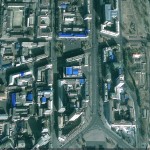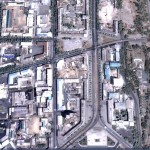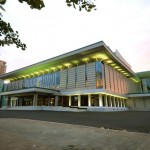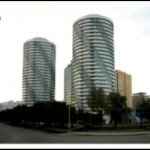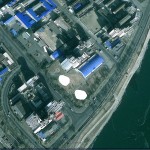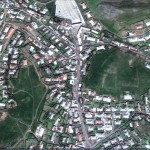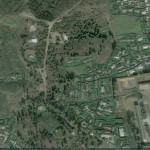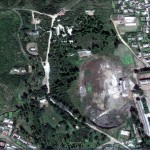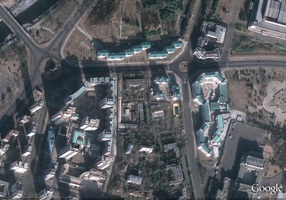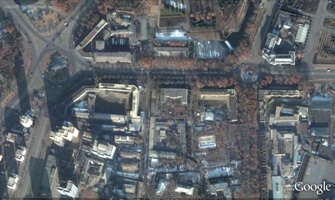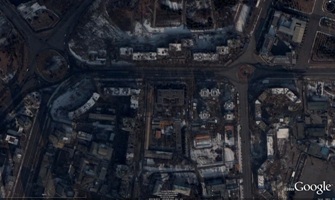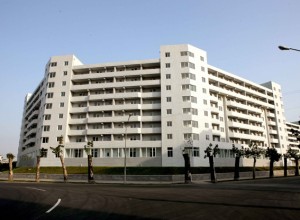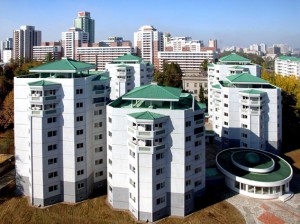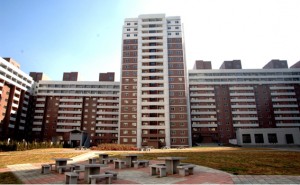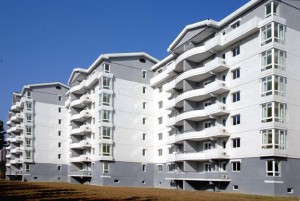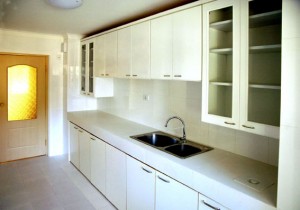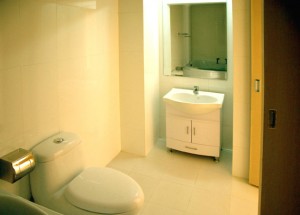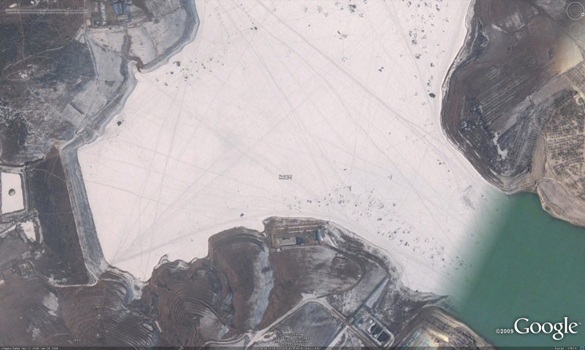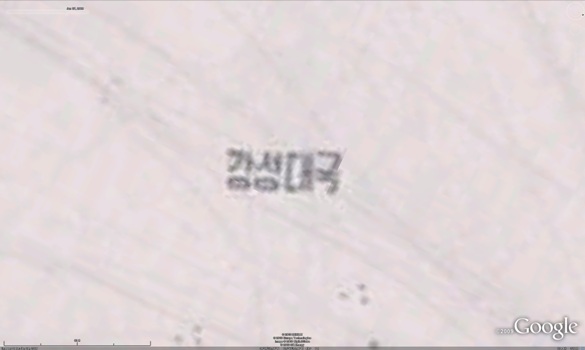Pictured Above (Google Earth): State (Drama) Theater before its most recent renovation
Pyongyang, October 8 (KCNA) — General Secretary Kim Jong Il gave on-the-spot guidance to the newly built State Theatre and visited artistes’ new flats.
He provided on-the-spot guidance to the newly built State Theatre.
The more than 620-seater theatre has all facilities necessary for art creation, performing activities and audience ranging from stage, latest sound and lighting facilities, rehearsal rooms, make-up rooms to an annex and welfare and service amenities.
He went round the exterior and interior of the theatre to learn in detail about its construction.
The theatre good in its interior structure and built on a high level is flawless in its architectural substance and style as a cultural and art edifice, he said, highly appreciating the feats performed by soldier- builders in successfully building the theatre of eternal value and extending thanks to them.
Noting that it is an astonishing miracle indeed that they completed the construction of such modern theatre to be proud of in a matter of little over four months, he stressed that this signal success is a striking manifestation of the inexhaustible mental power of the soldiers of the Korean People’s Army, the creators of the revolutionary soldier spirit.
The theatre which is a good combination of national and classical beauty and contemporary beauty and looks elegant, magnificent and exquisite is an excellent cultural edifice meeting the need of the new century, he noted, expressing great pleasure over the fact that it has become possible to hand one more valuable treasure to posterity.
He set forth tasks to be carried out to manage and operate the theatre.
He visited the families of the artistes who have just moved to the new apartment houses on the bank of the River Taedong.
He looked round the exterior and interior of the flats for hours to acquaint himself in detail with their construction.
The apartment houses for artistes are ultra-modern flats built according to the party’s plan and intention to provide the people with the best living conditions, he said, adding that these flats are a model and standard for the construction of the houses to be used by all the people in a thriving nation.
Noting that the flats for artistes were designed well and built on the highest level, he highly appreciated the feats performed by the soldier-builders in completing them in a short span of time and extended thanks to them.
Then he visited the families of Paek Sung Ran, Choe Kum Hyang and Kim Chol Jin, actresses and actor of the State Theatrical Troupe, and Ri Ji Yong, head of the troupe, who have just moved to the new flats.
After congratulating them on their moving to the new flats and having cordial talk with them, he took deep care of every aspect of their living as a real father would do. He bestowed upon them such great benevolence as presenting them with household articles in token of his visit.
He praised the artistes, noting that the artistes intensely loyal to the Party and the leader are the reliable sentinels standing on the ideological front to powerfully encourage the masses in the drive to implement the Party’s policies.
Noting that the Korean people’s age-old ideal and wishes are becoming a brilliant reality thanks to the high-pitched drive for effecting a great surge, he said that this stirring event in the era of the Workers’ Party has put on the horizon a rosy future of a thriving nation of Juche which will stand imposingly on this land.
Making the rounds of streets of the capital city taking on new looks day by day on the same day, he advanced highly important tasks which would serve as guidelines for turning Pyongyang into a more magnificent and beautiful city.
Noting that housing construction is of very weighty significance in settling the issue of the people’s living, he stressed that as an immediate task it is necessary to complete in the shortest possible period the construction of flats for 100,000 families in the city as modern as the apartment houses now standing in Mansudae Street and the newly built apartment houses for artistes.
He expressed great expectation and conviction that all the builders of the capital city would work new miracles in its construction in the new century and thus once again demonstrate the revolutionary spirit of the service persons and people of the DPRK, the successors to the great history and tradition.
He was accompanied by Kim Yong Nam, Choe Yong Rim, Ri Yong Ho, members of the Presidium of the Political Bureau of the WPK Central Committee, Kim Yong Chun, Kim Ki Nam, Choe Thae Bok, Yang Hyong Sop, Kim Kyong Hui, Kang Sok Ju, Ju Sang Song and Hong Sok Hyong, members of the Political Bureau of the WPK Central Committee, and Jang Song Thaek, Kim Yang Gon, Kim Yong Il, Pak To Chun, Choe Ryong Hae, Ju Kyu Chang, Ri Thae Nam, Thae Jong Su, Kim Phyong Hae, U Tong Chuk, Kim Jong Gak, Kim Chang Sop and Mun Kyong Dok, alternate members of the Political Bureau of the WPK Central Committee.
Before this news release, the theater was known as the “State Drama Theater”. KCNA reports only two performances here since 1996: here and here.
What is strange is that this is the second major renovation of the rarely-used theater in a decade. Below is a satellite image of the theater’s first renovation in June 2000 (Google Earth):
The new housing for the theater’s “artistes” does not appear on available satellite imagery, but its location is easy enough to determine using KCNA photos. Below is a picture of the new buildings as well as a photo of the location next to the Pyongyang’s central district market:

